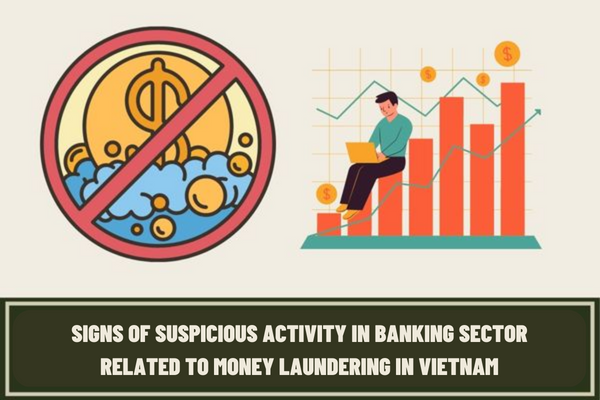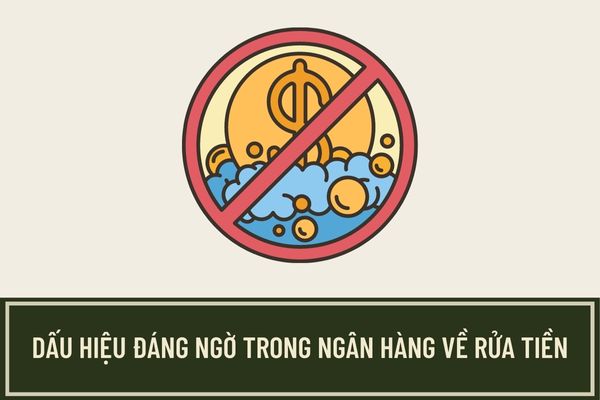What are the common signs of suspicious activity related to money laundering in Vietnam? What are 14 signs of suspicious activity in banking sector related to money laundering in Vietnam?
What are the common signs of suspicious activity related to money laundering in Vietnam?
Pursuant to Article 27 of the 2022 Law on Anti-Money Laundering in Vietnam, the common signs of suspicious activity related to money laundering are as follows:
(1) The customer refuses to provide information or provide inaccurate, inadequate and inconsistent identities.
(2) The customer induces the reporting entity not to report the transaction to the competent state authority.
(3) It is unlikely to identify a customer based on the information provided by the customer or a transaction relating to an anonymous party.
(4) The phone number provided by a customer does not work or exist after an account is created or a transaction is performed.
(5) The transaction is performed by order or according to the authorization obtained from entities and persons defined in the Greylist.
(6) The transaction can, based on the customer’s identification information or through examination of economic and legal concepts thereof, determine the connection between the parties involved and criminal activities or the association with the entities or persons appearing on the Greylist.
(7) The natural or legal person participates in a transaction at great expense, which is deemed as incommensurate with their business situation and income.
(8) The customer requests the reporting entity to carry out a transaction without conforming to the procedures and processes required by law.

What are 14 signs of suspicious activity in banking sector related to money laundering in Vietnam?
What are 14 signs of suspicious activity in banking sector related to money laundering in Vietnam?
Pursuant to Article 28 of the 2022 Law on Anti-Money Laundering in Vietnam, signs of suspicious activity in banking sector related to money laundering include:
(1) There is a dramatic change in the volume of transactions performed on an account; money flowing in or out from an account quickly; despite the great volume of transactions in a day, the balance remaining in an account is tiny or equals zero.
(2) A small amount of money is transmitted for a short while from different accounts to an account or vice versa; money is transmitted from or to multiple accounts; parties involved do not care about transaction fees; a lot of transactions, each of which is close to the great value requiring to be reported, are performed.
(3) A letter of credit and other trade finance facilities of which value is unusually great, and the proportion(s) of discount to value is high, are used.
(4) A customer has access to multiple accounts opened by credit institutions or foreign bank branches in a geographic area different from the place where he/she resides, works or does business.
(5) A customer’s account suddenly records a usually large amount of funds that are deposited or transferred.
(6) A large amount of funds are transmitted overseas from a company’s account after that account receives multiple small amounts that are wired or in form of cheques or drafts.
(7) A foreign-invested economic entity transmits money abroad after receipt of investment capital, or remits money overseas despite not allowed to do so according to its scope of business; a foreign investor transmits money abroad promptly after receiving funds from abroad to the account opened at any credit institution or foreign bank branch doing business in Vietnam.
(8) A customer frequently converts low-value banknotes into high-value ones.
(9) A transaction involving depositing or withdrawal of funds is performed by an entity or person creating illegal assets as a result of criminal activity that has been named on the mass media.
(10) A customer requests the lending of a permissible maximum amount for which it/he/she may provide security by using a life insurance policy of which total premium is paid on a lump sum basis promptly after payment of insurance costs.
(11) Information about the origin(s) of asset(s) used as financing, investment(s), lending or entrusted investment of a customer is not clear or transparent.
(12) Information about the origin of property put up as collateral of a customer requesting the lending of funds is incomplete and inaccurate.
(13) There is a suspicion that a customer uses a personal account for conducting a transaction relating to the structure of a legal person, or acting on behalf of other natural person to perform a transaction.
(14) Online transactions are performed through accounts that frequently change in terms of login devices or internet protocol (IP) addresses abroad.
What are the prohibited acts in the anti-money laundering in Vietnam?
Specifically, Article 8 of the 2022 Law on Anti-Money Laundering in Vietnam stipulates the prohibited acts in the anti-money laundering as follows:
- Organize, participate in or facilitate, assist in the conduct of money laundering.
- Create and maintain anonymous or pseudonymous accounts (or accounts in obviously fictitious names).
- Create and maintain business relationships with shell banks.
- Illegally provide services that involve the acceptance of cash, cheques, other monetary instruments and other stores of value and the payment to a beneficiary.
- Abuse public positions and power over anti-money laundering activities to prejudice the legitimate rights and interests of a natural or legal person.
- Hinder the provision of information necessary for anti-money laundering purposes.
- Intimidate and take revenge on the persons detecting and reporting money laundering offences.
LawNet
